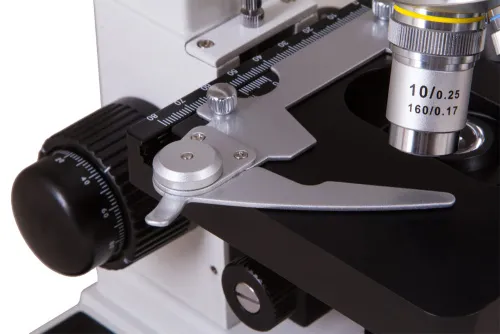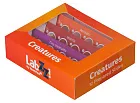Bresser Erudit DLX 40–600x Microscope
Magnification: 40–600x
Monocular
The microscope head is a core element of the microscope that you look through to see a magnified sample
40 — 600
How much the size of a sample increases when you observe it through a microscope
School/educational
Application and use of the microscope
| Product ID | 70332 |
| Brand | Bresser GmbH, Germany |
| Warranty | 2 years |
| EAN | 4007922200019 |
| Package size (LxWxH) | 46x30x22 cm |
| Shipping Weight | 3.8 kg |
Description
Bresser Erudit DLX 40–600x is an ideal tool for school research and hobby. This instrument is suitable for outside use thanks to the rechargeable battery. An integrated LED light and a height-adjustable condenser (with diaphragm and filter holder) provide optimal lighting. Achromatic DIN-lenses allow you to obtain high-quality views of the observed samples. 40x and 60x lenses are spring-loaded to protect samples and lenses from damage. The microscope has a 360° rotating monocular head, precise focusing, and an x-y stage with Vernier scale.
Features:
- Biological microscope
- 360° rotatable, 45° inclined monocular head
- Eyepiece: 10x with pointer
- Objectives: 4x, 10x, 40x, 60x
- x-y stage with Vernier scale
- LED illumination
- Condenser, height-adjustable
- Integrated dimmer
The kit includes:
- Bresser Erudit DLX 40–600x Microscope
- 10x Eyepiece
- 4 objectives (4x, 10x, 40x and 60x)
- Condenser (with diaphragm and filter holder)
- Blue filter
- Dust cover
- Power adapter
Specifications
| Product ID | 70332 |
| Brand | Bresser GmbH, Germany |
| Warranty | 2 years |
| EAN | 4007922200019 |
| Package size (LxWxH) | 46x30x22 cm |
| Shipping Weight | 3.8 kg |
| Type | biological, light/optical |
| Microscope head type | monocular |
| Head | 360 ° rotatable |
| Magnification, x | 40 — 600 |
| Eyepieces | 10x |
| Objectives | 4x, 10x, 40x, 60x (achromat DIN standard) |
| Revolving nosepiece | for 4 objectives |
| Stage features | mechanical, two-coordinate, with a Vernier scale and mechanical stage |
| Condenser | Abbe with a diaphragm and optical filter |
| Diaphragm | field |
| Focus | coarse and fine |
| Body | aluminum |
| Illumination | LED |
| Brightness adjustment | ✓ |
| Power supply | batteries or network adapter |
| Light filters | blue |
| Application | school/educational |
| Illumination location | lower |
| Research method | bright field |
| Pouch/case/bag in set | dust cover |
Reviews
Frequently Asked Questions – Microscopes (20.04.2020)
We have gathered answers to the most frequently asked questions to help you sort things out
We have gathered answers to the most frequently asked questions to help you sort things out
Eye under a microscope: insects’ photo (20.04.2020)
Find out why studying eyes under a microscope is entertaining; how insects’ and arachnids’ eyes differ and what the best way is to observe such an interesting specimen
Find out why studying eyes under a microscope is entertaining; how insects’ and arachnids’ eyes differ and what the best way is to observe such an interesting specimen
What does hair look like under a microscope? (17.05.2020)
Read this review to learn how to observe human hair, what different hair looks like under a microscope and what magnification is required for observations
Read this review to learn how to observe human hair, what different hair looks like under a microscope and what magnification is required for observations
How does the aperture of a microscope objective lens work? (17.05.2020)
Learn what a numerical aperture is and how to choose a suitable objective lens for your microscope here
Learn what a numerical aperture is and how to choose a suitable objective lens for your microscope here
A spider under a microscope: photos and peculiarities of studying the slide (18.05.2020)
Learn what a spider looks like under microscope, when the best time is to take photos of it, how to study it properly at magnification and more interesting facts about observing insects and arachnids
Learn what a spider looks like under microscope, when the best time is to take photos of it, how to study it properly at magnification and more interesting facts about observing insects and arachnids
What does a microscope consist of? (18.05.2020)
This review for beginner explorers of the micro world introduces you to the optical, illuminating and mechanical parts of a microscope and their functions
This review for beginner explorers of the micro world introduces you to the optical, illuminating and mechanical parts of a microscope and their functions
Paramecium caudatum - your first friend from the microworld (21.11.2016)
Short article about Paramecium caudatum - a microorganism that is interesting to observe through any microscope
Questions and Answers
Submit your question/feedback

















